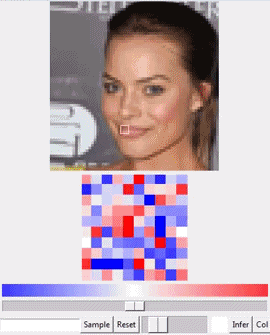A simple interface for editing natural photos with generative neural networks.



This repository contains code for the paper "Neural Photo Editing with Introspective Adversarial Networks," and the Associated Video.
To run the Neural Photo Editor, you will need:
By default, the NPE runs on IAN_simple. This is a slimmed-down version of the IAN without MDC or RGB-Beta blocks, which runs without lag on a laptop GPU with ~1GB of memory (GT730M)
If you're on a Windows machine, you will want to create a .theanorc file and at least set the flag FLOATX=float32.
If you're on a linux machine, you can just insert THEANO_FLAGS=floatX=float32 before the command line call.
If you don't have cuDNN, simply change line 56 of the NPE.py file from dnn=True to dnn=False. Note that I presently only have the non-cuDNN option working for IAN_simple.
Then, run the command:
python NPE.pyIf you wish to use a different model, simply edit the line with "config path" in the NPE.py file.
You can make use of any model with an inference mechanism (VAE or ALI-based GAN).
You will need Fuel along with the 64x64 version of celebA. See here for instructions on downloading and preparing it.
If you wish to train a model, the IAN.py file contains the model configuration, and the train_IAN.py file contains the training code, which can be run like this:
python train_IAN.py IAN.pyBy default, this code will save (and overwrite!) the weights to a .npz file with the same name as the config.py file (i.e. "IAN.py -> IAN.npz"), and will output a jsonl log of the training with metrics recorded after every chunk.
Use the --resume=True flag when calling to resume training a model--it will automatically pick up from the most recent epoch.
# You can generate a sample and reconstruction+interpolation grid with:
python sample_IAN.py IAN.pyNote that you will need matplotlib. to do so.
My MADE layer currently only accepts hidden unit sizes that are equal to the size of the latent vector, which will present itself as a BAD_PARAM error.
Since the MADE really only acts as an autoregressive randomizer I'm not too worried about this, but it does bear looking into.
I messed around with the keywords for get_model, you'll need to deal with these if you wish to run any model other than IAN_simple through the editor.
Everything is presently just dumped into a single, unorganized directory. I'll be adding folders and cleaning things up soon.
Remainder of the IAN experiments (including SVHN) coming soon.
I've integrated the plat interface which makes the NPE itself independent of framework, so you should be able to run it with Blocks, TensorFlow, PyTorch, PyCaffe, what have you, by modifying the IAN class provided in models.py.
This code contains lasagne layers and other goodies adopted from a number of places: